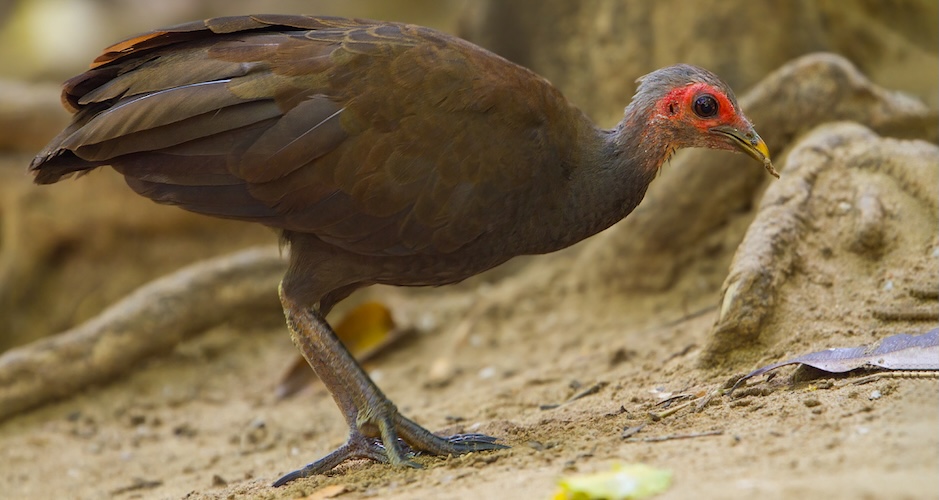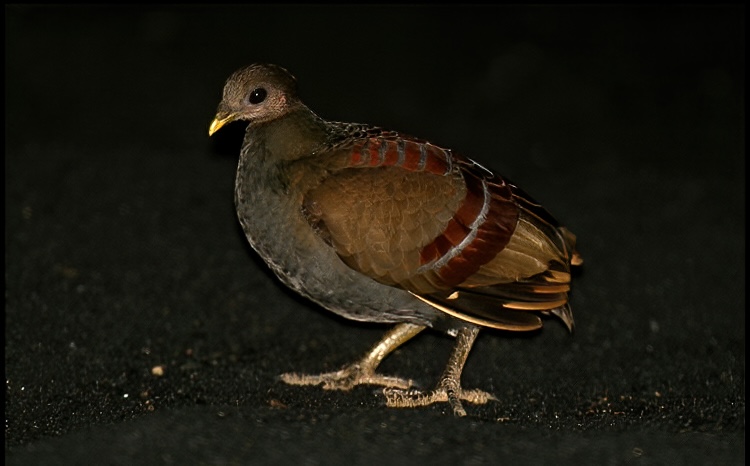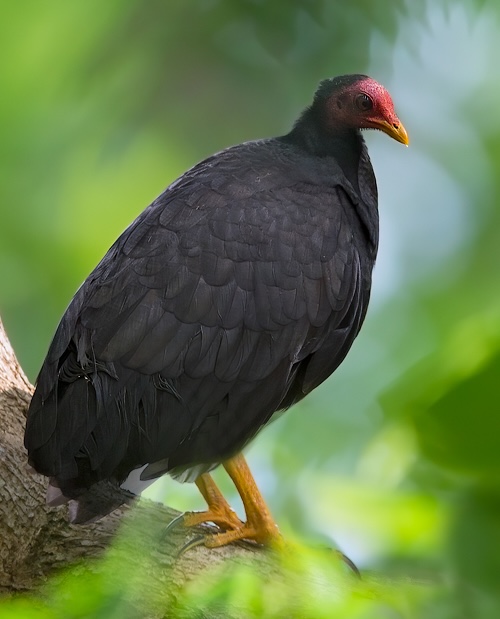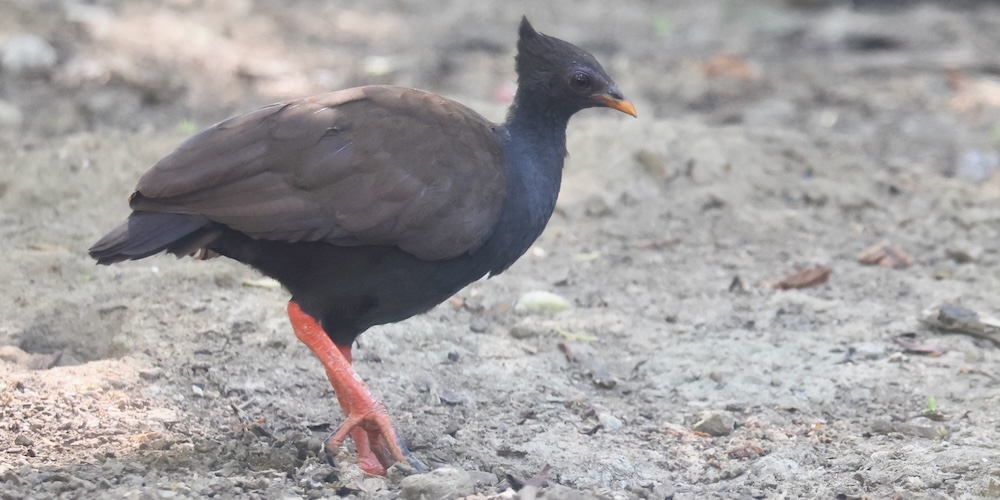Megapodiidae – Megapodes

The family known as Megapodiidae or megapodes are also known as incubator birds or mound-builders. They, along with Cracidae (Guans, Curassows & Chachalacas) Numididae (Guineafowl), Odontophoridae (New World Quails) and Phasianidae (Partridges, Pheasants, Grouse & Allies) are Galliformes, one of the largest of bird orders.
They are stocky, medium-large chicken-like birds with small heads and large feet. Their name literally translates from the Greek as ‘large foot’ and is a reference to the heavy legs and feet typical of these terrestrial birds. All are browsers, and all but the Malleefowl occupy wooded habitats. Most are brown or black coloured. Megapodes are super-precocial, hatching from their eggs in the most mature condition of any birds. They hatch with open eyes, bodily coordination and strength, full wing feathers and downy body feathers, and are able to run, pursue prey, and, in some species, fly on the same day they hatch.
They are medium-sized to large terrestrial birds with large legs and feet with sharp claws. They range from 28cm to 70cm. The largest members of the clade are the species of Alectura and Talegalla genera. The smallest are the Micronesian Scrubfowl Megapodius laperouse and the Moluccan Scrubfowl Eulipoa wallacei. They have small heads, short beaks, and rounded and large wings. Their flying abilities vary within the clade. They present the hallux at the same level of the other toes just like the species of the clade Cracidae, which are also Galliformes. The other Galliformes have their halluces raised above the level of the front toes.

Philippine Megapode Megapodius cumingii – ©Dubi Shapiro
They are found in the broader Australasian region, including islands in the western Pacific, Australia, New Guinea, and the islands of Indonesia east of the Wallace Line, but also the Andaman and Nicobar Islands in the Bay of Bengal. The distribution of the family has contracted in the Pacific with the arrival of humans, and a number of island groups such as Fiji, Tonga, and New Caledonia have lost many or all of their species.

Moluccan Megapode Eulipoa wallacei – ©Dubi Shapiro
Megapodes are mainly solitary birds that do not incubate their eggs with their body heat as other birds do, but bury them. Their eggs are unusual in having a large yolk, making up 50–70% of the egg weight. The birds are best known for building massive nest-mounds of decaying vegetation, which the male attends, adding or removing litter to regulate the internal heat while the eggs hatch. However, some bury their eggs in other ways; there are burrow-nesters which use geothermal heat, and others which simply rely on the heat of the sun warming sand. Some species vary their incubation strategy depending on the local environment.

Vanuatu Megapode Megapodius layardi – ©Dubi Shapiro
Although the Australian Brush Turkey was thought to exhibit temperature-dependent sex determination, this was later proven false; temperature does, however, affect embryo mortality and resulting offspring sex ratios. The non-social nature of their incubation raises questions as to how the hatchlings come to recognise other members of their species, which is due to imprinting in other members of the order Galliformes. Recent research suggests an instinctive visual recognition of specific movement patterns is made by the individual species of megapode.

Orange-footed Scrubfowl Megapodius reinwardt – ©Bird-Photo-Tours ASIA
Megapode chicks do not have an egg tooth; instead using their powerful claws to break out of the egg, and then tunnel their way up to the surface of the mound, lying on their backs and scratching at the sand and vegetable matter. Similar to other super-precocial birds, they hatch fully feathered and active, already able to fly and live independently from their parents.
Eggs previously assigned to Genyornis have been reassigned to giant megapode species. A lot of the dietary and chronological data previously assigned to dromornithids may instead be consigned to the giant megapodes.
-
Number of bird species: 21
According to the IOC there are 21 species, in seven genera, in the Megapodiidae family, part of the Galliformes order along with Cracidae (Guans, Curassows, and Chachalacas), Numididae (Guineafowl), Odontophoridae (New World Quails) & Phasianidae (Partridges, Pheasants, Grouse). They are:
Malleefowl Leipoa ocellata
Red-billed Brushturkey Talegalla cuvieri
Black-billed Brushturkey Talegalla fuscirostris
Collared Brushturkey Talegalla jobiensis
Australian Brushturkey Alectura lathami
Waigeo Brushturkey Aepypodius bruijnii
Wattled Brushturkey Aepypodius arfakianus
Maleo Macrocephalon maleo
Moluccan Megapode Eulipoa wallacei
Tongan Megapode Megapodius pritchardii
Micronesian Megapode Megapodius laperouse
Nicobar Megapode Megapodius nicobariensis
Philippine Megapode Megapodius cumingii
Sula Megapode Megapodius bernsteinii
Tanimbar Megapode Megapodius tenimberensis
Dusky Megapode Megapodius freycinet
Biak Megapode Megapodius geelvinkianus
Melanesian Megapode Megapodius eremita
Vanuatu Megapode Megapodius layardi
New Guinea Megapode Megapodius decollatus
Scrubfowl Megapodius reinwardt
-
Megapodiidae
Family AccountThese chicken-like Australasian birds, whose name means “big foot” in Greek, use their powerful feet to burst out of the shell. -
Megapodiidae
Family AccountThe megapodes, also known as incubator birds or mound-builders, are stocky, medium-large, chicken-like birds with small heads and large feet in the family...
As this is a relatively small family, Fatbirder has links below to all the birds in the clade…
-
Australian Brush Turkey Alectura lathami
Species AccountThe Australian Brush-turkey has a mainly black body plumage, bare red head, yellow throat wattle (pale blue in northern birds) and laterally flattened tail. The Australian Brush-turkey is not easily confused with any other Australian bird. It is the largest of Australia's three megapodes (Family Megapodiidae). The megapodes are a distinct family of the group of fowl-like birds (Order Galliformes), which includes quails, turkeys, peafowl and junglefowl. -
Australian Brush Turkey Alectura lathami
Species AccountSound archive and distribution map. -
Australian Brush Turkey Alectura lathami
Species AccountThe Australian brushturkey or Australian brush-turkey (Alectura lathami), also frequently called the scrub turkey or bush turkey, is a common, widespread species of mound-building bird from the family Megapodiidae found in eastern Australia from Far North Queensland to Illawarra in New South Wales. -
Biak Megapode Megapodius geelvinkianus
Species AccountA small, dark scrubfowl of forest and disturbed habitats on the Bay Islands where the only member of its family. Sooty gray plumage, bare red to gray face. -
Biak Megapode Megapodius geelvinkianus
Species AccountThe Biak scrubfowl or Biak megapode (Megapodius geelvinkianus) is a species of bird in the family Megapodiidae. It is found only on the islands of Biak... -
Biak Megapode Megapodius geelvinkianus
Species AccountSound archive and distribution map. -
Black-billed Brushturkey Talegalla fuscirostris
Species AccountA large, black ground bird of lowland rainforest. Bare gray facial skin, black bill and bright yellow legs. It is very shy and forages on the forest floor. -
Black-billed Brushturkey Talegalla fuscirostris
Species AccountThe black-billed brushturkey, yellow-legged brushturkey or black-billed talegalla (Talegalla fuscirostris) is a species of bird in the family Megapodiidae. -
Black-billed Brushturkey Talegalla fuscirostris
Species AccountSound archive and distribution map. -
Collared Brushturkey Talegalla jobiensis
Species AccountA large, black ground bird of rainforests from the lowlands to mid-mountains. Red-orange legs stand out against the all black plumage. -
Collared Brushturkey Talegalla jobiensis
Species AccountThe collared brushturkey, brown-collared brushturkey, or red-legged brushturkey (Talegalla jobiensis) is a species of bird in the family Megapodiidae. -
Collared Brushturkey Talegalla jobiensis
Species AccountSound archive and distribution map. -
Dusky Megapode Megapodius freycinet
Species AccountA uniformly blackish-brown megapode with a crested head. A bird of lowland forest, most often seen foraging on the ground singly or in pairs. -
Dusky Megapode Megapodius freycinet
Species AccountThe dusky megapode (Megapodius freycinet), also known as dusky scrubfowl or common megapode, is a medium-sized, approximately 41 cm (16 in) long, blackish bird. -
Dusky Megapode Megapodius freycinet
Species AccountSound archive and distribution map. -
Maleo Macrocephalon maleo
Species AccountSound archive and distribution map. -
Maleo Macrocephalon maleo
Species AccountA massive black-and-white megapode with a rose-pink breast and a diagnostic prominent knob on the nape. -
Maleo Macrocephalon maleo
Species AccountThe maleo (Macrocephalon maleo) is a large megapode and the only member of the monotypic genus Macrocephalon. -
Malleefowl Leipoa ocellata
Species AccountHeavily-built grayish ground-dwelling bird with short heavy legs, gray neck and chest, and strongly marked (camouflaged) back and tail. -
Malleefowl Leipoa ocellata
Species AccountThe malleefowl (Leipoa ocellata) is a stocky ground-dwelling Australian bird about the size of a domestic chicken (to which it is distantly related). -
Malleefowl Leipoa ocellata
Species AccountSound archive and distribution map. -
Melanesian Megapode Megapodius eremita
Species AccountA large-bodied, small-headed bird of odd proportions. Plumage is mostly dark, with dark legs and a dark head, but in good light shows a yellowish bill and... -
Melanesian Megapode Megapodius eremita
Species AccountThe Melanesian scrubfowl or Melanesian megapode (Megapodius eremita) is a megapode species that is endemic to islands within Melanesia. -
Melanesian Megapode Megapodius eremita
Species AccountSound archive and distribution map. -
Micronesian Megapode Megapodius laperouse
Species AccountA plump, mostly ground-dwelling bird with long yellowish legs, a dark blackish body, a tall light gray crest, a yellow bill, and a blood-red neck. -
Micronesian Megapode Megapodius laperouse
Species AccountThe Micronesian megapode or Micronesian scrubfowl (Megapodius laperouse) is a megapode which inhabits islands of the Western Pacific Ocean. -
Micronesian Megapode Megapodius laperouse
Species AccountSound archive and distribution map. -
Moluccan Megapode Eulipoa wallacei
Species AccountA partridge-like bird with an olive upper body, a mostly gray underside, and broad chestnut bands across the back and wings. -
Moluccan Megapode Eulipoa wallacei
Species AccountThe Moluccan megapode (Eulipoa wallacei), also known as Wallace's scrubfowl, Moluccan scrubfowl or painted megapode, is a small, approximately 31 cm long... -
Moluccan Megapode Eulipoa wallacei
Species AccountSound archive and distribution map. -
New Guinea Megapode Megapodius decollatus
Species AccountSound archive and distribution map. -
New Guinea Megapode Megapodius decollatus
Species AccountThe New Guinea scrubfowl or New Guinea megapode (Megapodius decollatus) is a species of bird in the family Megapodiidae. It is found in New Guinea... -
New Guinea Megapode Megapodius decollatus
Species AccountA dark megapode of lowland and foothill forest. Dark, sooty gray underparts and neck, dark brown back and wings, dark legs, reddish face or throat, yellowish... -
Nicobar Megapode Megapodius nicobariensis
Species AccountLarge, brownish bird with a small gray head and massive legs and feet. Forages on the ground in coastal forests in the Nicobar Islands. -
Nicobar Megapode Megapodius nicobariensis
Species AccountThe Nicobar megapode or Nicobar scrubfowl (Megapodius nicobariensis) is a megapode found in some of the Nicobar Islands (India). -
Nicobar Megapode Megapodius nicobariensis
Species AccountSound archive and distribution map. -
Philippine Megapode Megapodius cumingii
Species AccountOdd-looking partridge-like bird with a stunted head. Brown wings, gray underparts, and yellow bill. -
Philippine Megapode Megapodius cumingii
Species AccountThe Philippine megapode (Megapodius cumingii), also known as the Philippine scrubfowl or the Tabon scrubfowl, is a species of bird in the family Megapodiidae. -
Philippine Megapode Megapodius cumingii
Species AccountSound archive and distribution map. -
Red-billed Brushturkey Talegalla cuvieri
Species AccountA large, black ground bird of lowland and foothill forests. Red-orange bill, yellowish head, yellow eye and orange legs. -
Red-billed Brushturkey Talegalla cuvieri
Species AccountThe red-billed brushturkey (Talegalla cuvieri) also known as red-billed talegalla or Cuvier's brushturkey, is a large, up to 57 cm long, black megapode -
Red-billed Brushturkey Talegalla cuvieri
Species AccountSound archive and distribution map. -
Scrubfowl Megapodius reinwardt
Species AccountLarge gray-brown bird with a pointed crest on its head and massive orange legs and feet. Resident on the floors of tropical rainforests. -
Scrubfowl Megapodius reinwardt
Species AccountThe orange-footed scrubfowl (Megapodius reinwardt), also known as orange-footed megapode or just scrubfowl, is a small megapode of the family Megapodiidae -
Scrubfowl Megapodius reinwardt
Species AccountSound archive and distribution map. -
Sula Megapode Megapodius bernsteinii
Species AccountSound archive and distribution map. -
Sula Megapode Megapodius bernsteinii
Species AccountA dumpy, partridge-like bird with an obvious crest and powerful legs and feet. Uniform reddish-brown with dull orange legs. -
Sula Megapode Megapodius bernsteinii
Species AccountThe Sula megapode or Sula scrubfowl (Megapodius bernsteinii) is a species of bird in the family Megapodiidae. It is found only in the Banggai and Sula Islands -
Tanimbar Megapode Megapodius tenimberensis
Species AccountA large, dull-colored partridge-like bird with powerful legs and feet, an obvious crest, and pink facial skin. Shy. Singles and pairs inhabit the forest... -
Tanimbar Megapode Megapodius tenimberensis
Species AccountThe Tanimbar megapode or Tanimbar scrubfowl (Megapodius tenimberensis) is a small megapode endemic to the Tanimbar Islands of Indonesia. -
Tanimbar Megapode Megapodius tenimberensis
Species AccountSound archive and distribution map. -
Tongan Megapode Megapodius pritchardii
Species AccountA plump, mostly ground-dwelling bird with long yellowish legs and a dark gray body with slightly browner wash on the wings and back. -
Tongan Megapode Megapodius pritchardii
Species AccountThe Tongan megapode (Megapodius pritchardii) is a species of bird in the megapode family, Megapodiidae, currently endemic to Tonga. -
Tongan Megapode Megapodius pritchardii
Species AccountSound archive and distribution map. -
Vanuatu Megapode Megapodius layardi
Species AccountSound archive and distribution map. -
Vanuatu Megapode Megapodius layardi
Species AccountA large-bodied, small-headed, long-legged, mostly ground-dwelling bird. Easily identified by long bright yellowish legs, bright red face, entirely black... -
Vanuatu Megapode Megapodius layardi
Species AccountThe Vanuatu megapode or Vanuatu scrubfowl (Megapodius layardi) is a species of bird in the family Megapodiidae. It was formerly known as the New Hebrides... -
Waigeo Brushturkey Aepypodius bruijnii
Species AccountA very little-known, large, black ground bird endemic to the upland forests on Waigeo Island. Black above with some chestnut in the breast and a bare pink... -
Waigeo Brushturkey Aepypodius bruijnii
Species AccountThe Waigeo brushturkey (Aepypodius bruijnii) or Bruijn's brushturkey, is a large (approximately 43 cm long) brownish-black megapode with a bare red facial skin. -
Waigeo Brushturkey Aepypodius bruijnii
Species AccountSound archive and distribution map. -
Wattled Brushturkey Aepypodius arfakianus
Species AccountA large, black ground bird of montane rainforests. Bare facial skin is pale-blue in the male and dull gray in the female. -
Wattled Brushturkey Aepypodius arfakianus
Species AccountThe wattled brushturkey (Aepypodius arfakianus) is a species of bird in the family Megapodiidae. -
Wattled Brushturkey Aepypodius arfakianus
Species AccountSound archive and distribution map.
